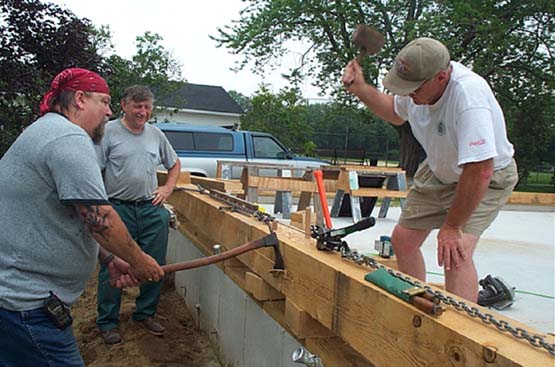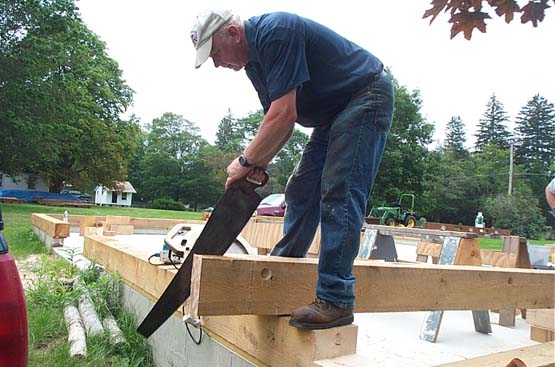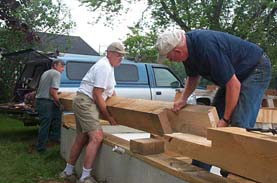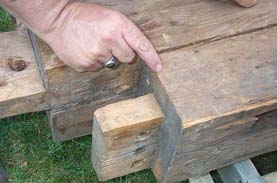By Liz Premo, Atlantic News Staff Writer
Atlantic News, Friday, August 4, 2006
[The following article is courtesy of Atlantic News]

[Atlantic News Photo by Liz Premo]

HAMPTON — It was just over two years ago that the c.1796 post-and-beam “Yankee” barn once situated at the corner of Drakeside and Lafayette Roads was in imminent danger of demolition.
Now, the antique structure is about to experience a rebirth, thanks to the combined efforts of the Hampton Historical Society, the town’s Heritage Commission, the NH Preservation Alliance and a group of local barn experts dedicated to seeing it stand tall once again.


‘X’ MARKS THE SPOT — (Top photo, l. to r.:) Percy Annis, Ben Moore and Chet Riley prepare to match up a joint for the sills in preparation for the eventual barn raising; (bottom photo) Dave DeGagne points out an “X” on a 200-year-old beam, upon which one of the original barn buildings left his measuring mark. [Atlantic News Photo by Liz Premo]
Once arrangements were made to turn the 38’x36′ barn over to the care of the Historical Society in June 2005, the structure was carefully dismantled. Since then, the barn’s coveted 200-year-old wood beams have been kept safe in storage.
Over the course of several months, a concrete foundation was laid on the grounds of the Tuck Museum, and a floor was poured this spring. Just last week, the wood sills (crafted from hemlock) were installed around the perimeter of the foundation.
Providing the (literal) sweat equity for the sill project during a week of hot and humid July days was the talented team of Dave DeGagne, Percy Annis, Chet Riley and Ben Moore. It was clearly a successful effort punctuated with cooperation, teamwork, an assortment of tools and plenty of expertise.
Taking a break from the heat one day while nursing a bit of a sore back, DeGagne surveyed the work in progress.
“It’s the base; the first part of the barn,” said DeGagne in reference to the sills. The joining ends of the sills come together at several points to form what DeGagne calls a “bladed scarf joint,” a style used to prevent potential twisting of the wood.
Once the joints have been fitted snugly together (much like a couple of pieces of a jigsaw puzzle) with the use of a “come-along” hook-and-chain winch, two holes are drilled at each joint and wooden pegs (hand made from red oak) are inserted.
Using a solid wooden mallet, the pegs are driven to within a couple of inches from the bottom of the sill. The exposed peg is sawed off and a small planing tool is used to make it flush with the surface.
Now that the sills are securely in place, the next step in the process is getting the beams — previously tagged in specific order by Riley — ready to go up. DeGagne said there are some repairs that need to be made to the beams before the three-bay, four bent building can start to take shape.
“After everything is fixed and repaired, then it’s time for a barn raising,” he said, adding that about 95 percent of the original frame was salvageable. “Every board and every stick has been numbered. We will put it back exactly where it came from.”
It’s interesting to take a close-up peek at the old beams, hewn two centuries ago from the abundant oak and pine trees growing in the area at the time. Often, carpentry marks made by those who measured, cut and shaped the beams back then can be seen in the form of an “X” scratched into the wood. Not surprisingly, those markings will come in handy when it’s time to reassemble the barn.
That’s not all that has been discovered.
“We find their boo-boos,” chuckled DeGagne, pointing out one patched-up mortice (a rectangular hole) used in the joining process. “We all laughed when we saw it.”
DeGagne revealed that the folks currently working on the barn have also found names of their predecessors, as well as various notes, the tracing of a hand, and “little scribbled messages” engraved into the beams.
Terms such as “gunstock post” and “English tine joint” apply to this type of antique workmanship, a tradition the crew intends to preserve in every way possible as the barn begins to take its familiar shape. Throughout, new walls and about 260 wooden pegs will be used to keep it all together.
Then there’s the tools. Sure, there was the modern electrical circular saw Riley used to cut through the thick wood used for the sills, but it was a jagged-toothed, hand-powered bucking saw that got the job done.
“That’s a power tool from 200 years ago,” said DeGagne of the bucking saw.
Also used for the sill project was a shipwright’s adze, a peavey hook, a low-angle block plane, a cant hook and a large wood mallet dubbed “The Commander,” used to pound the sill into place.
There’s also the traditional carpenter’s square DeGagne displayed, complete with the old-fashioned numbering system for determining the proper length of the braces used to support the structure’s walls.
Tools, talent, time and teamwork will all be put to good use as the barn project progresses. Meanwhile, the Hampton Historical Society is still in the process of raising the funds needed to complete the task.
Currently, the public can “purchase” a wood peg for $25. The peg will be engraved with the donor’s name, and will be used in assembling the barn. Sponsor donations are also being accepted in sums of $100 (and over) to $1000 or more; in fact, donations of any amount are appreciated.
A barn project photo album can be found at http://www.hamptonhistoricalsociety.org/barn.htm. For additional information, stop by the Tuck Museum at 40 Park Avenue or call (603) 926-0781.